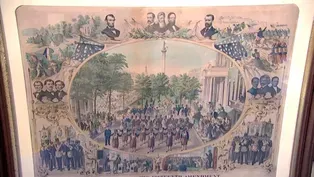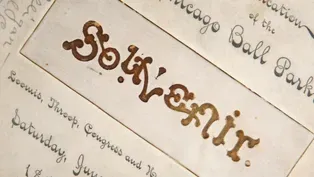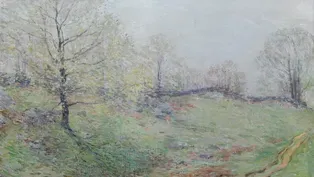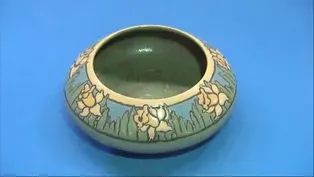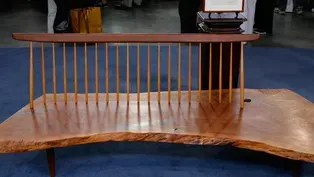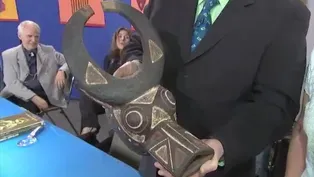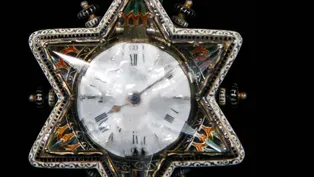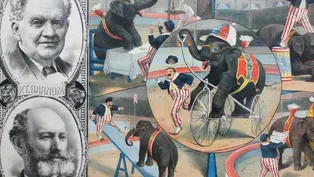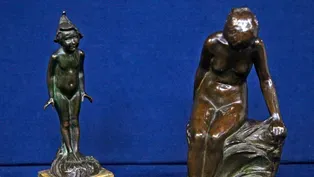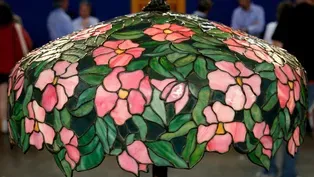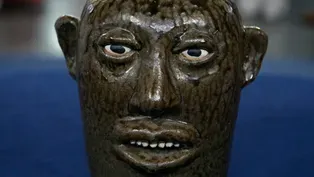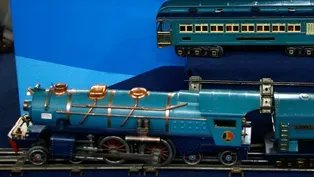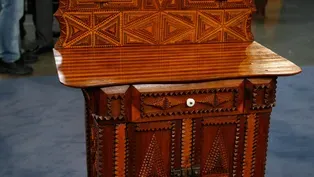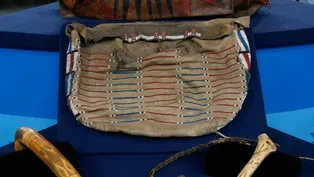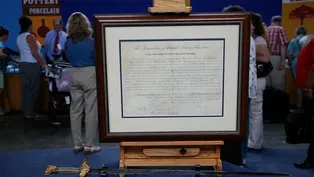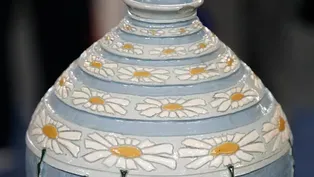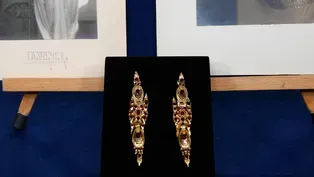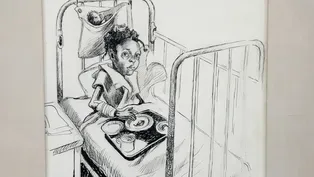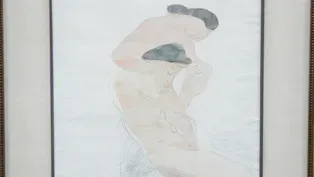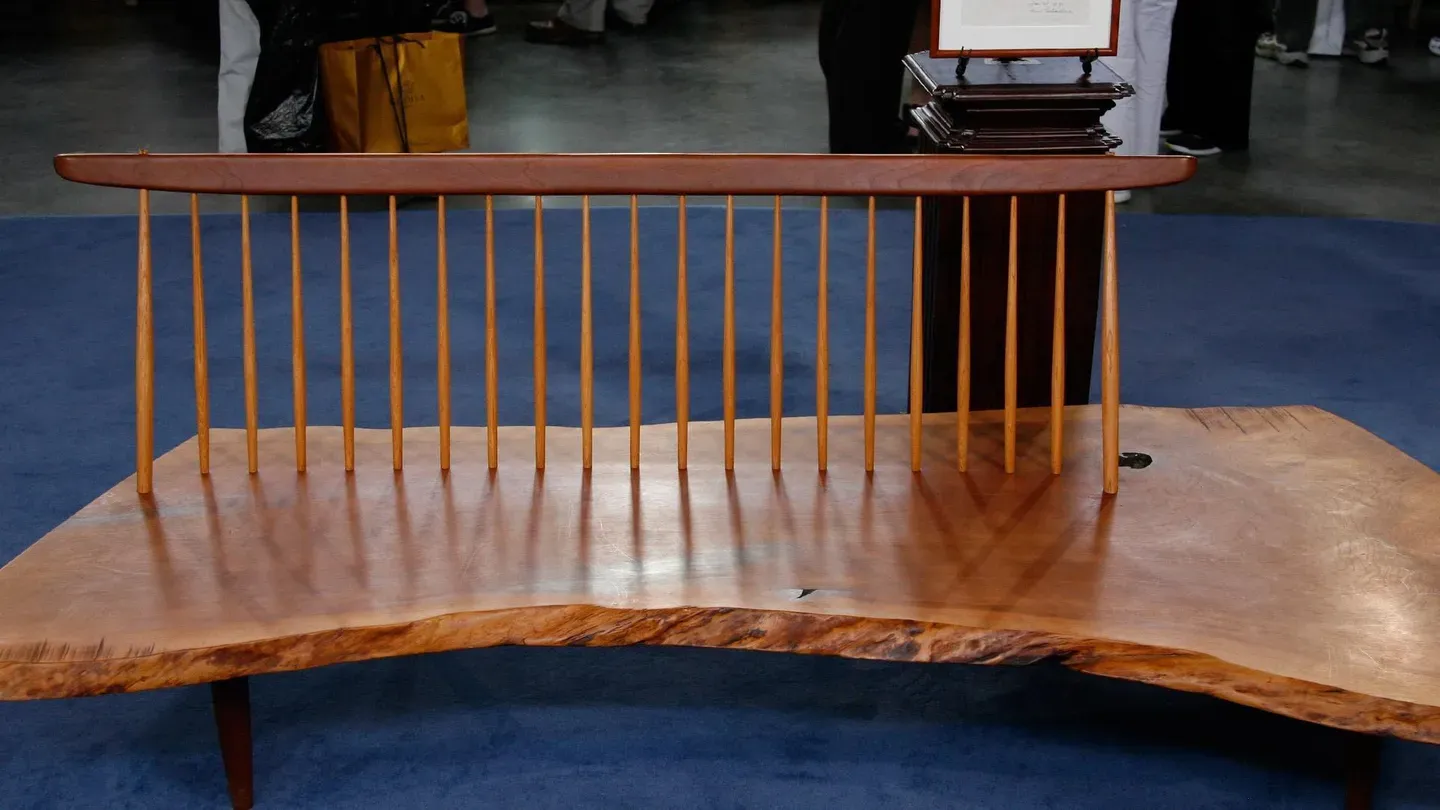

Vintage Baltimore 2021, Hour 1
Season 25 Episode 2 | 52m 29sVideo has Closed Captions
Travel back to 2007 for updates on Maryland finds, like a $130K-$200k appraisal!
Travel back to 2007 for updated appraisals on magnificent Maryland finds including Plains & Prairie American Indian art, a presentation sword with a Lincoln-signed appointment, and an 1885 Opening Day baseball program. One is $130,000-$200,000!
Funding for ANTIQUES ROADSHOW is provided by Ancestry and American Cruise Lines. Additional funding is provided by public television viewers.

Vintage Baltimore 2021, Hour 1
Season 25 Episode 2 | 52m 29sVideo has Closed Captions
Travel back to 2007 for updated appraisals on magnificent Maryland finds including Plains & Prairie American Indian art, a presentation sword with a Lincoln-signed appointment, and an 1885 Opening Day baseball program. One is $130,000-$200,000!
How to Watch Antiques Roadshow
Antiques Roadshow is available to stream on pbs.org and the free PBS App, available on iPhone, Apple TV, Android TV, Android smartphones, Amazon Fire TV, Amazon Fire Tablet, Roku, Samsung Smart TV, and Vizio.
Buy Now

ANTIQUES ROADSHOW 2025 Tour!
Enter now for a chance to win free tickets to ANTIQUES ROADSHOW's 2025 Tour! Plus, see which cities we're headed to!Providing Support for PBS.org
Learn Moreabout PBS online sponsorship♪ ♪ APPRAISER: I've been doing the Antiques Roadshow for 12 years.
This is one of the few authentic masks I've found.
(hisses) (laughing): That's amazing.
(laughing): Oh, my goodness.
Oh, my goodness!
♪ ♪ CORAL PEÑA: Back in 2007, "Antiques Roadshow" kicked off the season with our second visit to Baltimore, Maryland, where many wonderful treasures had been hiding.
It's a lovely desk, but you found something in the desk.
Yes, I did.
When I was cleaning it out to bring it, I found this envelope.
I have to tell you, in the ten years I've been doing "Antiques Roadshow," these are the finest things I've ever seen.
Really?
Oh, I'm so thrilled.
Yeah, they're absolutely beautiful.
I'm so thrilled.
PEÑA: What did our guests uncover?
And what is it all worth today?
You'll find out in the first hour of "Vintage Baltimore."
This desk belonged to my grandmother.
I can remember it when I was a little kid, and I just always admired it.
And now it's mine, and I treasure it very much.
It's a lovely desk.
You brought it here to the Roadshow, and did you find anything interesting about it?
Well, actually, I learned that it's not as rare as I had thought.
But you found something in the desk.
Yes, I did.
When I was cleaning it out to bring it, I found this envelope that contained an old photo of a sports team.
It's an old Western Union telegraph envelope, and it says "Chicago Ball Team 1885."
And this was your grandfather's handwriting, I assume?
No, it-- actually, it's my great-grandfather.
Well, why don't we take a look at what's in the envelope?
And we see it's a souvenir.
"Dedication of the Chicago Ball Park, Saturday, June 6, 1885."
Now, the Chicago Ball Park became known as West Side Park, and that's where the Chicago White Stockings played.
Now, the Chicago White Stockings was the name of the team that would later become the Chicago Cubs.
They're in the National League.
Oh, my.
They actually start in 1876.
So here we are, 1885, this is ten years later, and they needed a new park.
And this is the dedication souvenir program from that day.
They played the St. Louis Maroons, and they ended up winning the game.
Let's open up the program and see what's inside, shall we?
Okay.
Here we have an actual image of the West Side Park, and on the bottom, we have a team photograph.
They were captained by a gentleman named Cap Anson.
He was probably the 19th century's greatest hitter.
Oh, my.
Also on the team was Mike "King" Kelly.
Wow.
One of the greatest catchers of his day, and famous, they made a song, "Slide, Kelly, Slide."
Uh-huh.
And then even more interesting here is a young man named William Sunday, Billy Sunday.
He would go on to become one of the most influential evangelists in the United States.
(chuckles) Now we can turn it around.
We see here...
It gives the names.
Billy Sunday is underlined... Yeah, I don't know why.
...because he went on to become famous.
Now, 19th-century baseball collectibles are amongst the rarest and most desirable of all sports memorabilia.
That you got going for you here.
(chuckles) Then you have the Chicago Cubs, one of the most collected teams.
And the condition's amazing.
As far as value goes... Mm-hmm.
I'm curious, what did this desk come in at?
What was the price?
This was $2,500.
$2,500, which is... Yeah.
Yeah, that's not bad, it's beautiful.
Yeah.
It's beautiful.
Yes.
But you could probably buy about four of these desks.
(laughing) Because I would, I would estimate that between $8,000 and $12,000 at auction.
Oh, my God, that was just...
I had-- I just happened to bring it by chance.
It's a remarkable, remarkable piece.
I'm shocked.
I'm really shocked.
You've brought us a wonderful painting by an American artist named Willard Leroy Metcalf.
And what do you know about the artist?
I know that he was around New York, an upper-- lower Hudson Valley painter, and that he did a lot of work like this.
I've seen some online.
He did some work on Central Park, which looked not unlike this.
And beyond that, I know he's dead.
(both laughing) Well, that's true, that's true.
He actually was born in 1858 and died in 1925.
Okay.
And as opposed to being a Hudson River Valley, or Hudson River School artist, he actually is one of the two premier American Impressionist landscape painters.
Ah.
And he was from Lowell, Massachusetts.
Uh-huh.
And is really associated with the Boston School there.
Like many of the Impressionist artists, he went to France to study.
Uh-huh.
And then he came back and worked in, mostly in the Boston area, but also in Maine and the Berkshires, Cornish, New Hampshire, Vermont, and Old Lyme, Connecticut.
And I think this was probably done in Old Lyme, because there are other examples that show the rolling hills and the rocky landscape like this.
Interesting, interesting.
In 1898, he became part of a group called The Ten.
And this was composed of ten Impressionist painters, including William Merritt Chase... Yep.
Frank Benson, Edmund Tarbell, and the other premier Impressionist painter, John Twachtman.
Okay.
So he was in quite a distinguished group.
Yes.
Now, Metcalf really was almost purely known for doing landscapes.
You rarely see any figurative work by him.
And around 1901, he suffered a depression after his wife had left him... Got it.
...and his best friend, Twachtman, had died.
And so after that point, he almost has a revival.
And he changes his palette and his brushwork.
So, this painting, which is signed W.L.
Metcalf and dated 1906...
Right.
...was done after the depression and into this new era.
And what he's doing at this time is using very pastel colors.
Uh-huh.
So as you can see...
Right, right.
...we've got wonderful pastel colors.
He's letting the canvas show through in certain areas to show dimension.
And he also is using sort of a feathery, brushy technique here.
Now, tell me how you happened to acquire this.
Well, this was found in the attic of my late wife's grandfather's house.
He was the chairman of the board of the Pennsylvania Railroad.
Wow, oh, wow.
He had lots of paintings.
This was in the attic, and I was up there stomping around one day... (laughs) And somebody said, "Oh, don't step on that," because it was face down.
Right.
And they picked it up, looked at it, and said, "Well, why don't you take this?"
So I did.
And it was at the time surrounded by the ugliest rococo frame you've ever seen, which then my late wife replaced with this pecky cypress.
Right, and that, that particular frame that you got rid of is actually the type that the artist would probably have, have used on it, because... Then I probably shouldn't have thrown it away, but...
Probably not.
And also, there's a title on the stretcher on the back, which... Yeah.
Well, I think, I think it's "Reflections of Spring."
Right.
Have you ever had this evaluated?
Yes, I acquired this probably in 1966, and in 1968, my wife, who was an art major, took it in to an art museum, and they cleaned it up, and she said, "By the way, what do you think it's worth?"
And they said, "Oh, well, about $3,000."
Well, a painting like this, on the retail market, would generally sell for $150,000.
(laughing) Wow, that's pretty good for something that was free.
I think so.
I think so.
Holy smokes.
Yeah, he's very, very collectible.
That is, that... That, that's way over the top.
Yeah.
And fortunately, I've been hanging it out of the sunlight.
Well, that's good, that's good.
(laughs) I also think it could benefit from a cleaning.
It's a little dingy from the varnish probably yellowing.
35 years.
And you've got a couple of little paint losses here along the edge.
Yeah, yeah.
And the frame that you found it in, if it were the original, then the value of the painting might be more by, let's say, another $10,000, depending on the quality of it.
Right, yeah.
Well, thank you for bringing such a wonderful painting in today.
Thank you for enlightening me, I enjoyed it.
Oh, good.
Great, thank you.
I was afraid you were going to say, "Oh, nice $3,000, but it's actually worth 12 cents."
Oh, no, no, no.
(laughs) This piece is about 100 years old, and it was made by my grandfather, who was a self-taught carpenter and almost illiterate.
So, I'm very proud of the fact that he made this, and it's now in my possession.
It's tramp work, and it's made from cigar boxes.
My grandfather sat beside his wife while she was recuperating, and with a penknife, carved all these little tiny pieces.
Where was your family living?
They were living in Williamsburg, Pennsylvania.
Tramp art was home industry.
And everybody assumes that these were made out of cigar boxes.
And I think part of them could have been made out of cigar boxes, but you know as well as I do, there are some pieces in here that are bigger than what a cigar box would be.
Oh, yes.
I think what they really looked for was a wood that was kind of soft and easy to carve.
I think he did this to show his skill at lamination, and it alternates maple and walnut.
And what he did was, he took a strip the same width and depth all the way across and glued them together, and then he cut it to fit this and put this scallop in the front.
And the thing that I love the most about this is, it was a labor of love for him.
When I first walked up to it, the first thing I noticed were the hearts at the top of each mirror.
You noticed the hearts?
'Cause he made it for his sweetie, and something you almost never see is decoration on the bottom like that.
He's paid a lot of attention to detail.
Right.
Would you be surprised if I told you that this is worth $6,000 to $8,000?
(gasps) Yes.
(laughs) Yes, I would be very surprised.
Well, that's the case.
Well, it's going to stay in the family.
I'll never sell it.
It's not a good piece of pottery, okay?
(laughs) This is a, a creamware piece.
They put a transfer, a big decal on the surface, but it's called Rozane's Olympic Line.
It's one of the rarest Rozane lines.
And while you can get a piece of Rookwood brown glaze decorated with flowers...
Right.
...this size, worth $800 to $1,000, this one's worth between $2,000 and $3,000.
That's great.
It's a really extraordinary, rare piece of kind of low-end commercial American pottery, so congratulations.
(laughing): Thank you.
APPRAISER: It's pretty remarkable.
It's just such a large form, and it's wonderfully inset with all of these coins, all dating from the 17th century.
It has a date on this here by the handle, which is dated 1687, and the coins all seem to pre-date that, so I would think at auction, you're likely to see something the range of between $20,000 and $25,000.
Oh, my God.
That's unbelievable.
So it's quite a wonderful... That's remarkable, I would never have guessed.
MAN: This is a print of something that happened with the 15th Amendment that I know very little about.
I want to know a little more about it...
Okay.
...and maybe you can help me.
It was printed in 1870.
It's a hand-colored lithograph printed in Baltimore, which is nice, because we're finding it in Baltimore.
And it's African American troops and fraternal organizations marching up the street in celebration of the 15th Amendment, and what's particularly nice about it as a period piece is, it's showing a very patriotic and positive view of African Americans in a period when there weren't that many.
Period frame, looks like it's the old glass, just a very nice package.
Value, around $2,500.
Really?
That is wonderful.
It's great, and I will keep it.
(laughing) Enjoy it.
WOMAN: My mother gave them to my husband, who admired them for many years.
But my mother grew up on a beautiful farm in Greenville, Maine, beautiful mountain- lake region, and in the summer, they boarded travelers, and one of the boarders that came very often was a Baltimore socialite.
Her name was Eleanor Duvall.
A lot of these things we have that belonged to her came through my mother, and then she gave these to us last summer.
And when we brought them back home to Baltimore, we learned that they were Berges.
He was a popular sculptor, turn of the century, and other than that, I don't know a whole lot more.
Okay.
Actually, we think his name was pronounced "Ber-guee."
Berge, okay.
Right, Edward Berge.
Okay.
And he was born in Baltimore and he studied here, at the Rinehart School, and he later became a teacher at the Maryland Institute.
These pieces I would probably date from the 1920s or so.
Mm-hmm.
He was trained in a more classical tradition.
The beginning of the 20th century, there was a lot of avant-garde work going on, but he chose this traditional path.
Hm.
They're beautiful.
And that's exemplified in this wonderful nude...
Yes.
...that's beautifully observed and beautifully modeled.
What he's really known for are his fountains.
This is actually his most famous piece.
It's called "Wildflower," and he did a whole series of these pieces based on different flowers.
And they're really quite wonderful.
And I said it was a fountain, and this is a reduction.
Right.
He did these in a few different sizes.
Mm-hmm.
This was the smallest size.
He did one about 12 inches high, and then there's another one that's about 40 inches high.
And this one, not only is it signed by Berge himself, but in addition, it's signed here with "RBW"... RBW.
...which is the Roman Bronze Works.
Roman Bronze.
They were in New York.
The Roman Bronze had the models for these, and they were cast for a very long time by the family.
And I think some of them were cast well into the 1950s, if not the 1960s.
It's really beautifully done, very nicely detailed with a beautiful patina.
This one also is wonderful, because it has a great patina on it.
Yeah.
It's nicely modeled.
This one has a different foundry on it.
The foundry here is the Zappo Foundry in New York.
And it was very common for artists to have their things cast at different foundries.
I see.
In terms of the value, this reduction of his piece called "Wildflower" at auction would probably bring between $2,000 and $3,000.
No kidding.
Oh, no.
And this young lady here, again, beautifully cast bronze, I would think at auction would probably bring $3,000, $4,000.
Oh, no.
(laughs) Well, thanks for bringing them in.
Well, thank you so much.
Good.
In 1970, my dad decided to watch a football game with my brother, and my mom and I took a little drive into the country with a relative, and we went to New Hope, Pennsylvania.
She'd heard about a woodworker, George Nakashima.
So we went to his workshop, met him, and took a look at some of the furniture.
Within a couple of months, they decided they wanted a bench made and communicated with him, and he sent a drawing to us of what that bench would look like, and here it is.
It's extraordinary that you have this drawing by George Nakashima, truly a master American craftsman.
You met him in person?
We did, we did.
What was he like?
It was pretty exciting.
You know, I was 12 years old, and I just don't remember that much, I'm so sorry.
Well, I can maybe fill in a little bit of the blanks, because my brother went to school in the New Hope area.
Really?
And while he was driving around in his pickup truck, he met George, and George said to these bunch of teenagers, "If you guys," you know, "if you're driving around the countryside "and you see any big trees fallen down, call me first."
(laughs) Really?
Because, of course, he knew these kids were carousing in their pickup trucks at night.
I've seen furniture by George Nakashima, and the drawings, You notice along the top of it, it says, "Please confirm if satisfactory."
(laughs) I know-- I thought that was really special.
He lays it out for you.
He's even chosen the piece of wood, and in his studio, he had planks and planks of wood that...
I do remember that.
Do you?
Yes, I do.
Well, he was in love with wood.
And the thing that fascinates me about him, this great master of mid-century furniture, is that a lot of his contemporaries were making material in more a manufactured way, and he loved the hand process.
And so he chose these pieces so carefully, and you can really see that.
I mean, it comes to life in this drawing, where he talks about the textured knot.
And, of course, the textured knot is right here in front of us.
I mean, there's just no mistake that this drawing goes to this bench.
It's just this combination-- of course, he's a Japanese American, born in Washington-- but this combination of Americana and also Japanese sensibilities.
The top of this bench looks to me like a torii arch from Japan, coming into a Shinto temple.
It does.
And when George came to the New Hope, Pennsylvania, area in the '40s, he looked at Americana and looked at Windsor benches.
So this is this 18th-century Windsor bench brought into a 20th-century sensibility.
A lot of his furniture was done in a walnut.
There was a lot of walnut in the Pennsylvania area.
He also uses imported woods, as well, but, but this is a cherry, and probably indigenous.
And then these stiles are hickory.
Any idea of its value?
We had it valued by the Nakashima Group in early 2000, and it was, I think, around $6,000.
But I'd love to get an update on that, because I'd really like to have it insured.
Well, your parents paid $375 for this?
Yes.
The market has exploded in Nakashima furniture.
Benches like this at auction are selling for $40,000.
Oh, my God.
Now, because you have the drawing, you get to add a few thousand more on top of that.
So say we're at the $45,000 mark.
For insurance, you might want to raise it higher.
But this is, I'd say $45,000.
Oh, my God.
It's just red-hot now in the marketplace.
Well, we love it, and we use it every day in the living room, so we take very good care of it.
WOMAN: The woman in the photograph is Lucrezia Bori, and my husband's great-aunt was her personal secretary for all of her career.
Lucrezia Bori is from Spain.
These were her earrings, and we have pictures of her wearing them in several operas.
You can see here she's got the earrings in a shorter style, and then here in the much longer version as we see here on the table.
What's interesting about these earrings is that the central parts are detachable.
And so she could wear them in a variety of styles.
These are Spanish, and I know you said she was of Spanish descent, and so these were probably family pieces.
These date from the 18th century.
They were based on much earlier designs, and they continued to be redone and updated for each of the centuries.
Both the 17th and 18th, and even 19th century.
But these are definitely an 18th-century pair of earrings.
They're made of gold and garnet, and if I turn them over, one thing to point out-- the tops of these are not original.
These are a later addition.
Okay.
But you can see there are these little tabs on the back that are used to separate each of the corresponding segments.
And then the back has a little bit of an engraving, just to make them a little more interesting on the back.
The reason these were divided into sections weren't so much used for changing the design of the piece, but these earrings were quite heavy to wear all the time.
And so when ladies were going to their event or evening out, when they were in their carriages, they would take the lower sections off, so that they weren't so heavy, and upon arrival to their destination, they would put the bottom sections back on just so to give their ears a little relief for the evening.
They're in excellent condition.
We don't see many of these, and I think the fact that you have the history, the photographs, I would say that you would probably want to insure these from anywhere between $8,000 and $10,000.
(hisses) (laughing): That's amazing.
Wow.
Thank you.
Unbelievable!
WOMAN: I was a college student, and I went to the Folklife Festival, the Smithsonian in Washington, DC, on the Mall.
I went into a tent, and this was there, and I fell in love with it.
And there was a man that was there, and I told him I was a college student and I didn't have a lot of money, so I said I...
He said, "Do you like anything?"
I said, "I like that."
He said, "I tell you what.
How much do you have?"
I had about $30, and so he let me have it for $30.
I love it.
So how many years ago was that, approximately?
30?
When you walked in with this face jug, as they call it, I recognized that it's possibly a piece that was made by the Meaders family.
I recognized it by the glaze, which is called a tobacco-spit glaze.
And you can just picture it.
Oh!
It looks like dripping tobacco juice that someone might have spit on it.
When we turn it over, we now see the signature, and the signature is that of Lanier Meaders.
And he was born in 1917.
Oh!
And he was the second son of Georgia potters Cheever and Arie Meaders.
They became very famous in Georgia.
The Library of Congress honored them in the 1970s.
Oh, God, I didn't know...
So they actually had a very, very high regard in the field of American folk pottery.
My sisters never liked it.
So every time they would come to my house, they would turn the face to the wall.
It's interesting you say that, because sometimes, the other name for the pottery is grotesque face pottery.
(laughing) So some of them are actually quite distorted and scary.
I think this is wonderful.
It's very dignified.
Value in today's market, somewhere in the $1,500 to $2,500 range.
I love it.
Thank you so much.
Well, thank you for bringing it to "Antiques Roadshow."
Thank you.
I had no idea.
It's a really well-detailed model.
I first saw the Shot Tower about 20 years ago, my first trip to Baltimore, and the Phoenix Shot Tower was actually used to make lead shot for shotguns.
They would drop lead shot off the top, and as it fell, it would form a perfect sphere.
Reasonable retail price would be somewhere in the $1,000 to $1,500 range for a piece like this.
Oh, yeah?
It would have been worth quite a bit of money had no one ever gotten to it.
Somebody has done a lot of over-finishing.
They were trying to repair these cracks here, but they didn't do a very good job.
This guitar, in excellent condition, would have been worth about $15,000.
In the condition it's in now, I'd say around $3,000, $3,500.
This one just had all the wrong things done, but probably done during an era when people weren't thinking that these were worth any real money.
MAN: I went to antique shop.
Saw that belt across the room.
It was in the late '60s, early '70s, and I think we finally agreed on $150.
I figured it was silver, and I wanted to wear it.
Well, what you picked up was a belt that was made in the '30s by the Navajos.
The materials it's made out of is silver.
A belt like this today would sell for about $3,000 to $5,000 at auction.
Okay.
Well, I wish it still fit.
You wanted to wear it.
(laughs) I wore it for years.
Were you an old hippie back then?
Yes, of course.
I got it at a yard sale in Maryland.
Okay, what did you pay for it?
I paid $15 for it.
Okay, why did you buy it?
Well, I bought it because this lady had a whole lot of them and told me that her husband was a curator with a museum.
This is a mask from what used to be called Upper Volta, which is now called Burkina Faso.
The tribe is Nunuma, and it's in the central area of Burkina Faso.
What we like to see on masks is, first of all, this has wonderful wear all along this edge here, great old break in there.
Right there, yeah.
We come around, we have some nice wear on the front.
And I'm telling you, I've been doing the Antiques Roadshow for 12 years, this is one of the few authentic masks I've found.
Is that right?
This is the real deal.
I figured it was, because...
This is the real deal.
He was a curator of a museum, so...
These masks are used as bush spirits to communicate with the creator.
This is really lovely.
And they did wear it on their face as a mask?
Yeah, it's worn-- if you'll pardon me, it's worn like this.
Oh.
And that's the way it's danced.
What do you think it's worth?
It's got to be worth more than $15.
How about $5,000 to $7,000?
Oh, my word, I would've... Yup.
Oh, my God.
Yeah, this is really a nice, good, solid mask.
It's in good condition and it's old.
Oh, my gosh, thank you so much.
Should I say congratulations?
Yes, you should.
Okay, I will.
(both chuckle) It was my late husband's, and it was a particular treasure of his.
He was a graphic artist and he collected a lot of posters.
This is the most interesting, I think.
Being from the Bridgeport area, where Barnum had his museum and the circus had its winter headquarters and everything, there was local interest, but we both really loved the headline, so typically Barnum.
I think, from my research, that Jumbo was killed in 1885.
Hit by a train.
And Jumbo the elephant was a big star of the circus, and it was a horror that he was killed.
And so Barnum had to do something to rescue the circus, and he came up with this story that Jumbo had sacrificed himself and thrown this elephant out of the way of the oncoming train to save its life.
It's a great headline.
And this may come as a surprise to you, but for some reason, I'm very partial to images of men dressed as clowns.
(laughing) I don't know what it is, but it really, it resonates with me.
Yes.
P.T.
Barnum was considered the world's greatest huckster.
And early circus posters are a wonderful window into the history of American advertising.
The circuses would travel from town to town, and as they were moving from town to town, an advance team of advertisers would be in the next town hanging up posters.
And the circuses in America really revolutionized poster art in America.
Oh.
And revolutionized advertising art.
The poster was printed by one of the great American lithographers, the Strobridge Company, which was based in Cincinnati.
And their name appears on all the posters that they printed, and they really are the gold standard for American turn-of-the-century commercial lithography.
Now, on most early circus posters, not only does it say Strobridge, but it has the date of the poster.
Oh!
This series, with the two cameos-- the two very desirable cameos, from the point of view of circus collectors-- these were never dated.
But they date to approximately the early 1890s.
Really?
So it was a little bit after Jumbo died.
Now, you mentioned the headline.
The headline is great.
You've got to imagine a man standing outside the big top going, "The original, famous, and only "diminutive, dwarf "clown elephant, Tom Thumb, "to save whom Jumbo so nobly sacrificed his own life.
Inimitable displays of elephantine intelligence."
(chuckles) This would've really excited people, along with all the great vignettes of the elephant playing music, the elephant bicycling, the elephant ordering drinks.
This would have really excited people to come and visit.
The circus posters from the '30s and '40s, which were printed in much larger numbers, tend to sell in the $200, $300, $400 range.
At auction, I would estimate its value at between $2,000 and $3,000, and it's in very good condition, too.
The colors are still bright.
So it wouldn't surprise me if it would sell closer to the high end of that rather than the low end.
Great.
Great-- my husband would be very pleased.
I need a pair of red-striped pants.
(laughing) That would be perfect.
MAN: We think we have a 17th-century watch.
We think it's from France, and the story in our family is, it may have actually been a remake of an earlier watch.
And so we know it has some enamel on it and some silver, but that's really as much as we know about it.
And when you brought it to me, there was a little bit of a mystery.
I had to do a little research.
First, you notice, it's very ornate.
There's a lot going on there.
The movement is done by a watchmaker that was out of London around 1768 through the latter part of the 1700s.
So you're right on the money there, as far as the watch.
But whoever put together the piece itself put it together later.
Now, on the back, there's a little hook where this should be worn over a sash or on a heavy garment.
This is very ornamental.
The hallmark-- it's an export mark-- tells us that it was made sometime between 1891 and 1901.
Now, where is it from?
Not France.
Oh.
Austria-Hungary.
And it's very typical of this type of enamel work done on top of silver.
Beyond that, what looks like glass is not glass.
Is it rock crystal?
Is that... Yeah, that's good.
Okay.
And it's not molded.
You have to start by taking a solid piece of rock crystal.
And usually this was done in Idar-Oberstein, Germany.
And they would sit down and hand-cut these pieces out.
They actually cut a cylinder for the watch movement to fit into.
They cut this top piece.
They put all the facets on it.
It's a lot of work.
And don't think they got it right the first time.
I'm sure... Really?
...a piece may have broken, they threw it in the pile, they had to start all over again.
You can see where they had to hollow out the rock crystal.
Right.
Now, there's a lot of interest in these watches.
A very strong market for this today.
Probably in the neighborhood, at auction, of $20,000 to $30,000.
Amazing, hmm.
That's, that's unbelievable to hear.
Does the fact that it may be a Judaic piece add any value or take any value from...
It's interesting you bring that up, because it's a six-pointed star.
Austria and Hungary, they used this form a lot and it didn't necessarily have anything to do with Judaica.
Thanks for bringing it in.
Thank you.
WOMAN: Well, my father-in-law was clearing out a house, and the owner said that he was going to get rid of a pile of junk, and asked him if he wanted to keep any of it.
And my mother-in-law put a print on it and hung it in her office for about ten years.
And then when she retired, she put it up in the attic.
After about five years or so in the attic, she gave it to me, and it hung in my house for about five years, until I decided that I would change the frame.
And when I opened it up, I saw this striking girl.
I immediately was drawn to her.
I didn't recognize the name "Benton" on the bottom.
I started to do a little research, and then I found out it was Thomas Hart Benton's drawing.
So is it still that original frame that it was in?
It's the same frame.
Okay, okay.
And the same matte, and I just protected it with U.V.
glass, and I've really been enjoying it in my house.
And now, what do you know about the subject of the drawing?
It's a study for a mural that's hanging at the Indiana University.
I think the mural was commissioned for the state fair in the early 1900s.
And if you see the picture of the mural, the little girl is right in the middle.
It is a Benton drawing, and it's a really wonderful Benton drawing.
He's known as an American regionalist painter, primarily.
This is executed in pen and ink.
The drawings are not quite as well known as the paintings.
There are these very sort of active, sinewy figures in a lot of the paintings.
There are landscapes that are very, very distinctive.
He was also known as a mural painter.
He actually was commissioned to paint this mural cycle for the Chicago World's Fair in 1933, and it represented the Indiana pavilion at the fair.
And he spent a lot of research, a lot of time in Indiana.
He came up with the idea of a cycle that represented the history of industry in Indiana and the history of culture in Indiana.
And it deals with the cultural aspect of the parks, circuses, the press and-- here's the controversial part-- the Klan.
He was anxious to show history as it really was in Indiana, and he wanted to represent the Ku Klux Klan.
There was a real controversial aspect to that.
And he had to get permission to do it, and he went through the State House, and so on.
Ultimately, it was granted.
This drawing represents a figure in panel number ten.
And this panel depicted the racial issues in Indiana in the 1920s, apparently, from what research I've been able to do.
When the fair was over, the whole thing went into storage.
Apparently, nobody really wanted it.
And then at some point in the late '30s, the president of Indiana University decided that they'd like it for the university, and it was reinstalled in the university.
But to this day, there's a big controversy over the aspect of the panel that deals with the Klan.
But the whole situation has really changed in terms of marketability and things, because whereas these things were perhaps not very desirable in the past, there's tremendous interest in this now.
Images depicting Black history in America are very, very sought after.
You had told me you had this appraised once, and they told you...
I had it appraised about ten years ago, in Philadelphia, and he said that the art market was somewhat low, and there was no market for African American art, so he said that, probably about $2,000.
Well, that may have been the case there, or he may have been misinformed.
It's certainly not the case now.
A really finished Benton drawing of this kind of quality and of such a fascinating subject matter, in today's market, I would say an auction estimate on this drawing conservatively would be somewhere in the perhaps $12,000 to $18,000 range.
Really?
You really found a treasure under that Monet print in that frame, and I really appreciate you bringing it to us today.
Thank you, thank you.
You're welcome.
Well, I brought a ceremonial sword that was given to my great-great-grandfather in about 1856.
And he later became the consul to Bavaria, and I brought his certificate naming him as the consul.
Well, who was the sword presented by?
It was presented by his men in the...
It was the Philadelphia Artillery Brigade in the Pennsylvania militia.
And it was presented at the time also by the governor of Pennsylvania and Simon Cameron, who eventually became Lincoln's first secretary of war.
Correct.
Do you know what that regiment was called?
His regiment ultimately became the 27th Pennsylvania.
At the time, they were just a militia brigade, right?
I found a neat reference to them.
They're actually the Philadelphia Flying Artillery.
Oh, okay.
And he's the man that actually founded it.
Okay.
Which is why they were giving him this token of their esteem.
It's got a beautiful presentation on the front, where it was presented by his men "To General Max Einstein."
Right.
Wonderful presentation.
The sword itself is made by the Ames Manufacturing Company in Chicopee, Massachusetts.
And it has the correct Ames mark on the back of the scabbard.
This is pretty much the pinnacle of an Ames sword.
Beautifully executed.
It has the original silver handle with beautiful floral and geometric patterns on the grip.
Mm-hmm.
Eagles everywhere.
Right.
Eagles on the crossguard, eagles on the pommel cap.
Beautifully done sword.
This was the top that Ames made.
Wow.
Have you been able to do much research about when the sword was given to him?
We have a book that mentions it.
The book is called "The Jews of Philadelphia."
And it's mentioned... no doubt, the author actually went to his home.
He said it was hanging on the wall, and there's a description of the presentation, and it mentions Cameron and the governor of Pennsylvania, who I think was John Pollock.
And the appointment mentions where he was being made consul to His Majesty, the King of Bavaria.
And what's interesting about this is, not only is it an important piece of paper of history, it's also important because of who it's signed by.
This one has a full ink signature all in his hand, deep colors, no fading.
It's a beautiful signature.
And if you notice, it's dated in 1861.
That's early in Lincoln's presidency.
Also a wonderful thing to have with it.
It's not a sword that you'd ever decide to sell.
Right.
So I'd insure it for $15,000.
(chuckles) It's been hanging on a wall for years and years, you know, so... And the appointment, with the good, clear signatures, is something you would need to insure for around $5,000.
Okay, that's good to know.
Fantastic piece.
These are incredibly intricate carvings made out of cork.
They are depicting the Summer Palace and the Winter Palace in Beijing.
Yes.
And they were done probably in the late 19th- early 20th century.
They're worth about $1,000 apiece.
Uh-huh.
I think they're just lovely.
Thank you for bringing them in.
MAN: My dad made them, passed them on to me, so... APPRAISER: These types of miniature tools, I wouldn't want to call them common, but they're not rare, either.
What is rare is that you have this complete group.
We know who made them.
Right.
They've been kept in the family and kept together like this.
For insurance purposes, you would want to cover these for something around $4,000.
All right, that's very good.
Yeah.
WOMAN: I know that it's a bulb pot.
It was in my grandmother's house the whole time I was growing up, and it was something that I had asked her, and when she passed away, I, I took it.
(laughs) What do you do with it now?
I plant bulbs in it.
You put bulbs in it, okay.
(laughing): Yes.
Well, what we have here is actually a piece of pottery from the Boston area, and it is called a Saturday Evening Girl bowl.
Saturday Evening Girl is a really interesting story.
And it actually comes from a group of philanthropists in Boston just around the turn of the century, and they decided they wanted to give immigrant girls a wage, and they'd pay them on Saturday to come in and decorate pottery and porcelain.
The way this is done here is, they carve the surface of the pottery and then they glaze around it.
And we know that this is Saturday Evening Girls because, on the bottom, we have here...
It says "S.E.G."
It says "S.E.G."
I thought they were someone's initials.
They are-- Saturday Evening Girls.
But this is actually someone's initials here.
And that "S.G." stands for Sara Galner, who was one of the more important artists that Saturday Evening Girls employed.
And below it is the date "9-11."
So it's done in September of 1911.
So not only do we know who made it, we know when it was made and where it was made.
And the fact of the matter is... Wow... ...you should be not using it as a bulb pot.
(laughs): Oh, okay.
It's worth probably-- it has a little hairline here-- but it's worth probably around $2,000.
(breathlessly): Oh, my God.
(laughing) Those are some lucky paperwhite bulbs, I'm telling you.
(laughing) (laughing): Oh, I don't even want to think about what I've done with this pot.
MAN: It belonged to my uncle, then my cousin got it.
Then my cousin died and his wife asked me if I'd like to have it.
Now, you're a train buff?
Not until this one.
(laughs) Do you know much about Lionel Company?
I know they've been in business a long time, but, uh... Well, we'll fill in a few blanks for you.
Okay.
First of all, Lionel was actually the middle name of Joshua Lionel Cowen-- earlier Cohen, but later Cowen.
He came over to the States, and in the late 1800s, he developed the flash powder that photographers use.
And it was so successful, the Navy contracted to use this flash powder for mine detonation.
This is how he got his stake and he could start the Lionel Train Company, which he thought of when he saw a small fan, and he tried to figure out how to use it.
And he figured he'd put in a little motor, and that's when he started with the toy trains.
He's the one who invented this size, which is called standard gauge.
And what he endeavored to do with standard gauge was to make the most beautiful, luxurious trains for kids possible.
And this is considered to be one of his greatest accomplishments, the Blue Comet.
It came out in the early 1930s, about 1930 to 1938.
This was actually based after a real train.
Oh, is it?
1929 to 1941, there's a train called the Blue Comet that ran a New Jersey Central Line down to Atlantic City and the Jersey Shore.
It was called the seashore's finest train.
And it was competing with Pennsylvania Railroad.
It was painted blue because of the Jersey seashore.
And guess what?
The Blue Comet, the Faye, the Westphal, and the Tempel here, all named after comets.
No kidding.
The train was so beautiful that people would actually wait for it to come down the tracks so they could watch it go by.
Three hours from door to door, that's what they advertised.
And they advertised the finest in luxury.
And when Joshua Lionel Cowen created this train, that's what he wanted to do, as well.
Let's take a look.
The actual train had triple-cushioned mohair seats.
They even show a bathroom and a commode.
There was a smoking room for the gentlemen.
There was an observation deck, which you see in the back of this train...
Right.
And they had all the luxuries for that time.
Right.
For a Lionel train, this is unheard of.
You could never take the top off, and of course it had the spectacular electric light.
All the little details were thought of to make this like the actual-size Blue Comet.
Now, at the time this was sold, $70 to buy this in the 1930s, at the height of the Depression.
You could buy a three- piece bedroom suite or you could buy a used Model T for that kind of money.
Oh, my.
For auction, I would put this at estimate $8,000 to $10,000.
Oh, my.
It's sold as much as $11,500.
Good heavens.
Uh, makes me want to treasure it even more.
WOMAN: I bought it at an auction about 25 years ago.
Paid around $15.
I bought it because I like daisies, and I don't know anything about pottery.
My girlfriend Michelle collects pottery, and she saw it and told me that it was an early Roseville piece.
It's Rozane Ware.
She looked it up in a book and said the value for a mint condition was around $3,000.
So since it's not mint condition, I was wondering what the value was.
This particular line is called Della Robbia.
The original Della Robbias were Italian, but the name was taken for this particular line, which was designed by Frederick Hurten Rhead.
Now, Frederick Rhead was an Englishman, and he came over to this country in about 1902, and he joined Roseville in 1904, and he really transformed what they were doing over there.
It gave them a really wonderful Arts and Crafts look, but with a lot of style, a lot of English style.
And he designed 72 different models, starting in 1906.
Now, sometimes they're actually done by his hand, but often they're done by other workers.
Most Roseville we know as being cast and having little hand-painting.
This is entirely hand-carved and -excised.
Now, there were two different generations of Della Robbia.
This is the early one, with many beautiful colors.
The later one is usually done in one or two complementary colors.
There are initials on the bottom, too.
Which are probably from the person who did the carving.
That is the initial of the worker.
And underneath, we'll see the "Rozane Ware," which is a particular time period in Roseville history, where they would sign their pieces with this medallion.
Now, there's some damage here.
There's little chips on the enameling.
You can have it repaired if you wish.
Per chip, it'll cost maybe $100 to $150.
Most pieces of Della Robbia have some kind of damage to them, or restoration, because it's a very porous, low-fired item.
Because this piece, with its lovely daisies-- which also looks great from the top, by the way-- is so wonderful, so great, so rare, even with all these little flakes, at auction, we would certainly put that at $10,000 to $15,000.
You're kidding!
Okay.
Right now, my husband's jumping up and down, saying, "Sell, sell, sell!"
(laughing) These came down to me from my great-grandfather, who acquired them out in, uh, Nebraska.
He ran the government store among the Indians from 1871 to 1873.
And while he was out there, of course, he interacted with the various tribes that came through, and this is just a small sampling of the items he brought back.
I think I'll start with the trunk up on the top here.
These are called parfleche trunks.
Now, normally, they were in an envelope size.
They would be much flatter, and they were used to store meat.
A big trunk like this-- there was only a couple of groups that made these trunks, and they were more for clothing.
Oh.
They're made out of buffalo rawhide.
The paint is probably a Chinese vermilion that was traded out onto the Plains, and a black, which was probably charcoal.
This probably dates to about the 1830s or '40s.
Uh-huh.
The second piece, they call these possible bags.
You can put anything possible in them.
Good name.
It was used to store clothing and things like that.
And they weren't worn, they were just put on the inside of a teepee or an earth lodge.
Mm-hmm.
This one is really nice because you can pinpoint-date it.
It has three different style beads.
It has a really fine seed bead, and then it has a size we call a real bead, and then it has the larger-sized pony beads.
These are called pony beads because they were brought out on pack horses, ponies.
Okay.
This is made out of buffalo hide, and because of all these three size beads, we can date this right to about the 1840s.
Wow.
Then we have an elk antler quirt.
These are used as a horse whip and also as a weapon.
They'd clout an enemy on horseback with this.
Mm-hmm, it's, it's quite substantial.
Yeah.
And that has a nice trade cloth strap with some minimal beadwork and a beautiful buffalo-hide lash on it.
And last but not least, we have a elk horn scraper the women would use to, to clean their hides.
This is a particularly nice one.
These dots probably represent hides.
It's a tally, it's a... Oh!
It's how many hides they, they skinned with it.
Oh, for heaven's sake.
This one has wonderful iconography, especially these military figures up here.
The type of uniforms they're wearing date to the late 18th- early 19th century.
It's kind of difficult to say exactly which tribe made these objects, but since he was in Nebraska, the Pawnee were in Nebraska, the Iowa were near there, and the Sac-Fox were near there.
I have to tell you, in the ten years I've been doing "Antiques Roadshow," these are the finest things I've ever seen.
Really?
Yeah, they're, they're absolutely beautiful.
Oh, I'm so thrilled, I'm so thrilled.
Starting with the parfleche trunk, I would put a auction value of about $20,000 to $30,000 on this.
Oh, my goodness.
(laughs) The possible bag, I'm going to put $30,000 to $50,000.
Mmm.
The elk horn quirt, which is one of the finest ones I've ever seen, I'm going to put $30,000 to $50,000 on that.
(laughs): Oh, my goodness, oh!
The scraper is a masterpiece.
This is the finest elk horn scraper I've ever seen.
Mmm.
And conservatively, I'm going to put an estimate of $50,000 to $70,000 on it.
Oh, my word, I'm just...
I'm just blown away, I really am.
That's wonderful.
So, just these four pieces, I would conservatively say $130,000 to $200,000.
Well, they're, they're real treasures, and...
They are absolutely treasures.
And I'm, I'm so pleased that we have retained them and they can be passed down through the generations.
I'm glad you have, too.
PEÑA: You're watching PEÑA: And now it's time for the "Roadshow" Feedback Booth.
This is our 90-year-old bean pot-- not really-- um, worth millions-- not really-- but $15.
And we had a great day today.
We did.
We brought our "antiques" sign, but we can't find the one that says "roadshow."
We brought this book, which we thought was a first edition of "To Kill a Mockingbird," and it's not.
Turns out it's not-- it has a barcode on it.
In 1960, they didn't have barcodes, so, um, probably should have thought of that before I brought it in.
Mom, you know that rosary you thought we'd fight over when you passed away, and you, we could take it out of your coffin?
Well, you can take it with you, 'cause it's not worth anything.
We still may fight for it, though!
(laughs) I brought in my Baltimore Colts 1970 Super Bowl World Champions ball autographed by most of the team, and they appraised it today at about $2,000 or $3,000, which is a couple of thousand more than I thought it was going to be.
And I found out that my vase here that I believed was possibly worth a lot of money is only worth about $100.
But I certainly had fun.
We thought it was worth a billion.
(both laugh) And I emailed all my friends, and I told them I was coming to the Antiques Roadshow.
And if these were going to price high, I was leaving here, and I was driving straight to New York and put them on the auction-- and not come back to work.
But the value of this was $300 and this was $300.
So Monday, I'll see you at work.
Take care, thank you.
PEÑA: Thanks for watching.
See you next time on "Antiques Roadshow."
Appraisal: 1870 Fifteenth Amendment Celebration Print
Video has Closed Captions
Appraisal: 1870 Fifteenth Amendment Celebration Print (57s)
Appraisal: 1885 Chicago Opening Day Baseball Program
Video has Closed Captions
Appraisal: 1885 Chicago Opening Day Baseball Program (3m 19s)
Appraisal: 1906 William Leroy Metcalf Oil Landscape
Video has Closed Captions
Appraisal: 1906 William Leroy Metcalf Oil Landscape (4m 19s)
Appraisal: 1911 Sara Galner Saturday Evening Girls Bowl
Video has Closed Captions
Appraisal: 1911 Sara Galner Saturday Evening Girls Bowl (1m 48s)
Appraisal: 1971 George Nakashima Conoid Bench & Drawing
Video has Closed Captions
Appraisal: 1971 George Nakashima Conoid Bench & Drawing (3m 39s)
Appraisal: 20th C. Nunuma Buffalo Mask
Video has Closed Captions
Appraisal: 20th C. Nunuma Buffalo Mask (1m 45s)
Appraisal: Austro-Hungarian Rock Crystal Watch, ca. 1900
Video has Closed Captions
Appraisal: Austro-Hungarian Rock Crystal Watch, ca. 1900 (2m 32s)
Appraisal: Barnum & Bailey Circus Poster, ca. 1896
Video has Closed Captions
Appraisal: Barnum & Bailey Circus Poster, ca. 1896 (3m)
Appraisal: Edward Berge Bronze Sculptures, ca. 1920
Video has Closed Captions
Appraisal: Edward Berge Bronze Sculptures, ca. 1920 (3m 7s)
Appraisal: Gorham Leaded Glass Lamp, ca. 1905
Video has Closed Captions
Appraisal: Gorham Leaded Glass Lamp, ca. 1905 (29s)
Appraisal: Lanier Meaders Face Jug, ca. 1975
Video has Closed Captions
Appraisal: Lanier Meaders Face Jug, ca. 1975 (2m 7s)
Appraisal: Lionel Blue Comet Train, ca. 1935
Video has Closed Captions
Appraisal: Lionel Blue Comet Train, ca. 1935 (2m 57s)
Appraisal: Pennsylvania Tramp Art Dresser, ca. 1910
Video has Closed Captions
Appraisal: Pennsylvania Tramp Art Dresser, ca. 1910 (2m 13s)
Appraisal: Plains & Prairie Indian Art
Video has Closed Captions
Appraisal: Plains & Prairie Indian Art (3m 41s)
Appraisal: Presentation Sword & Lincoln-signed Appointment
Video has Closed Captions
Appraisal: Presentation Sword & Lincoln-signed Appointment (3m 9s)
Appraisal: Roseville Rozane Della Robbia Vase, ca. 1906
Video has Closed Captions
Appraisal: Roseville Rozane Della Robbia Vase, ca. 1906 (2m 50s)
Appraisal: Spanish Gold & Garnet Earrings, ca. 1760
Video has Closed Captions
Appraisal: Spanish Gold & Garnet Earrings, ca. 1760 (2m 19s)
Appraisal: Thomas Hart Benton Drawing, ca. 1933
Video has Closed Captions
Appraisal: Thomas Hart Benton Drawing, ca. 1933 (3m 54s)
Appraisal: Unauthenticated Auguste Rodin Drawing, ca. 1900
Video has Closed Captions
Appraisal: Unauthenticated Auguste Rodin Drawing, ca. 1900 (1m 3s)
Providing Support for PBS.org
Learn Moreabout PBS online sponsorshipFunding for ANTIQUES ROADSHOW is provided by Ancestry and American Cruise Lines. Additional funding is provided by public television viewers.


